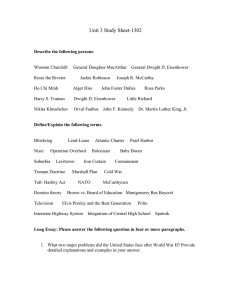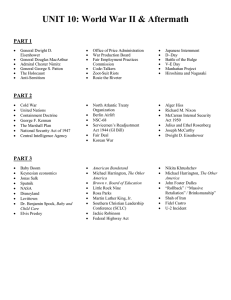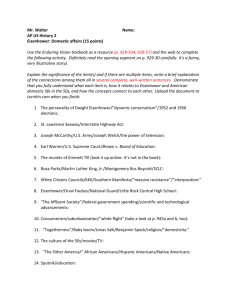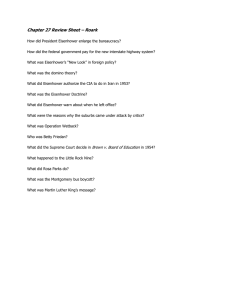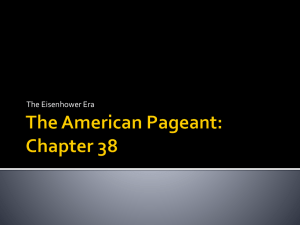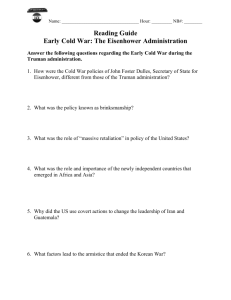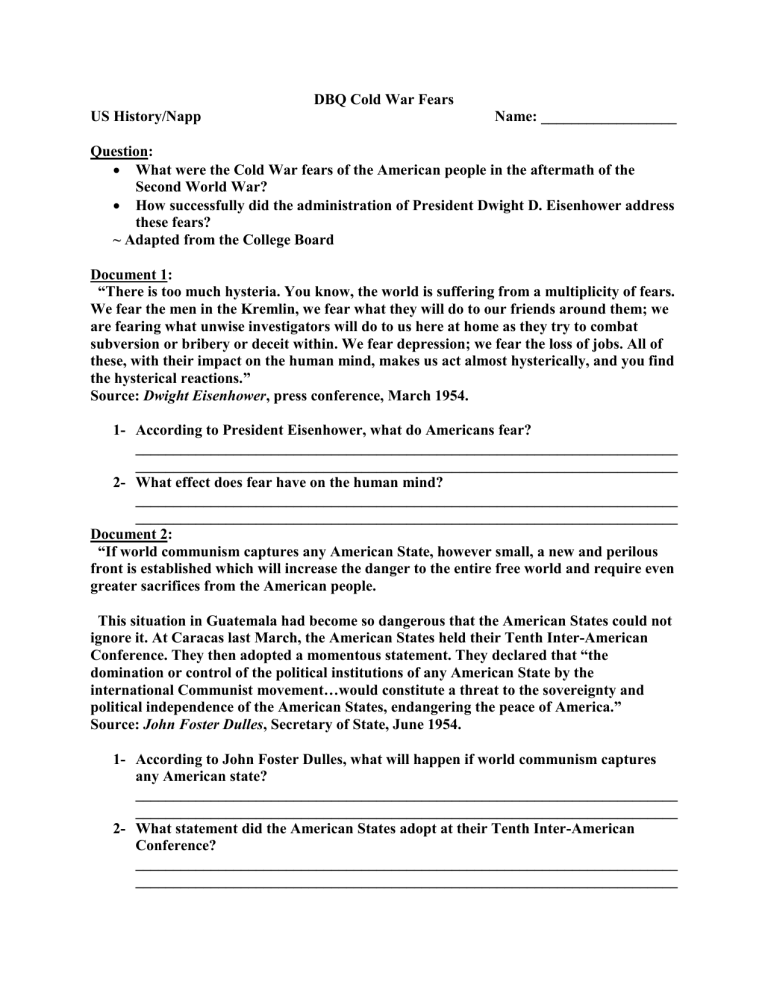
DBQ Cold War Fears US History/Napp Name: __________________ Question: What were the Cold War fears of the American people in the aftermath of the Second World War? How successfully did the administration of President Dwight D. Eisenhower address these fears? ~ Adapted from the College Board Document 1: “There is too much hysteria. You know, the world is suffering from a multiplicity of fears. We fear the men in the Kremlin, we fear what they will do to our friends around them; we are fearing what unwise investigators will do to us here at home as they try to combat subversion or bribery or deceit within. We fear depression; we fear the loss of jobs. All of these, with their impact on the human mind, makes us act almost hysterically, and you find the hysterical reactions.” Source: Dwight Eisenhower, press conference, March 1954. 1- According to President Eisenhower, what do Americans fear? ________________________________________________________________________ ________________________________________________________________________ 2- What effect does fear have on the human mind? ________________________________________________________________________ ________________________________________________________________________ Document 2: “If world communism captures any American State, however small, a new and perilous front is established which will increase the danger to the entire free world and require even greater sacrifices from the American people. This situation in Guatemala had become so dangerous that the American States could not ignore it. At Caracas last March, the American States held their Tenth Inter-American Conference. They then adopted a momentous statement. They declared that “the domination or control of the political institutions of any American State by the international Communist movement…would constitute a threat to the sovereignty and political independence of the American States, endangering the peace of America.” Source: John Foster Dulles, Secretary of State, June 1954. 1- According to John Foster Dulles, what will happen if world communism captures any American state? ________________________________________________________________________ ________________________________________________________________________ 2- What statement did the American States adopt at their Tenth Inter-American Conference? ________________________________________________________________________ ________________________________________________________________________ Document 3: Source: Life magazine, May 1955. 1- What is the purpose of this shelter? ________________________________________________________________________ ________________________________________________________________________ Document 4: On last June twenty-ninth, with President Eisenhower’s signature, one of the most astounding pieces of legislation in history quietly became a law. Public Law 627 represents such a monumental conception of national public works that its accomplishment will literally dwarf any previous work of man…That new title – the National System of Interstate and Defense Highways – tells the story of the road network, which will receive the major portion of the brave new effort to get this country out of its national traffic jam. The Interstate System…is the 40,000-mile network of existing roads which comprise our trunkline highways; it connects 209 of the 237 cities having a population of 50,000 or more and serves the country’s principal industrial and defense areas. Source: Saturday Evening Post, October 1956. 1- Describe the National System of Interstate and Defense Highways and explain its significance. ________________________________________________________________________ ________________________________________________________________________ Document 5: Source: U.S. News and World Report, December 1957. 1- What policy is being questioned and why is this policy being questioned? ________________________________________________________________________ ________________________________________________________________________ Document 6: Source: Herblock, The Washington Post, January 1958. 1- Explain the meaning of the political cartoon. ________________________________________________________________________ ________________________________________________________________________ Continue to next page Document 7: “Because of the national security interest in the quality and scope of our educational system in the years immediately ahead, however, the Federal Government must also undertake to play an emergency role. The Administration is therefore recommending certain emergency Federal action to encourage and assist greater effort in specific areas of national concern. These recommendations place principal emphasis on our national security requirements… If we are to maintain our position of leadership, we must see to it that today’s young people are prepared to contribute the maximum to our future progress. Because of the growing importance of science and technology, we must necessarily give special – but by no means exclusive – attention to education in science and engineering.” Source: Special Message to the Congress from President Eisenhower on Education, January 1958. 1- According to President Eisenhower, what is of great interest to the Federal Government? ________________________________________________________________________ 2- What does President Eisenhower want to maintain? ________________________________________________________________________ 3- According to President Eisenhower, what academic subjects must be given special attention in schools? ________________________________________________________________________ Document 8: Source: Historical Statistics of the United States, Statistical Abstract of the United States, Department of Commerce. 1- Identify two significant changes in the United States in the years 1949 to 1959? ________________________________________________________________________ 2- What accounts for these changes? ________________________________________________________________________ Document 9: “Let every nation know, whether it wishes us well or ill, that we shall pay any price, bear any burden, meet any hardship, support any friend, oppose any foe to assure the survival and the success of liberty… Finally, to those nations who would make themselves our adversary, we offer not a pledge, but a request: that both sides begin anew the quest for peace, before the dark powers of destruction unleashed by science engulf all humanity in planned or accidental selfdestruction. We dare not tempt them with weakness. For only when our arms are sufficient beyond doubt can we be certain that they will never be employed. But neither can two great and powerful groups of nations take comfort from our present course – both sides overburdened by the cost of modern weapons, both rigidly alarmed by the steady spread of the deadly atom, yet both racing to alter that uncertain balance of terror that stays the hand of mankind’s final war.” Source: President John F. Kennedy, inaugural address, January 1961. 1- According to President Kennedy, what will the United States do for the success of liberty? ________________________________________________________________________ ________________________________________________________________________ 2- What request does President Kennedy make? ________________________________________________________________________ ________________________________________________________________________ 3- According to President Kennedy, why must the U.S. be strong? ________________________________________________________________________ ________________________________________________________________________ Sorting Documents: Sort the documents according to the questions. Which documents can be used to answer each of the following questions? What were the Cold War fears of the American people in the aftermath of the Second World War? How successfully did the administration of President Dwight D. Eisenhower address these fears? The Essay: Introduction ______________________________________________________________________________ ______________________________________________________________________________ ______________________________________________________________________________ ______________________________________________________________________________ ______________________________________________________________________________ ______________________________________________________________________________ ______________________________________________________________________________ ______________________________________________________________________________ What were the Cold War fears of the American people in the aftermath of the Second World War? ______________________________________________________________________________ ______________________________________________________________________________ ______________________________________________________________________________ ______________________________________________________________________________ ______________________________________________________________________________ ______________________________________________________________________________ ______________________________________________________________________________ ______________________________________________________________________________ ______________________________________________________________________________ ______________________________________________________________________________ ______________________________________________________________________________ ______________________________________________________________________________ How successfully did the administration of President Dwight D. Eisenhower address these fears? ______________________________________________________________________________ ______________________________________________________________________________ ______________________________________________________________________________ ______________________________________________________________________________ ______________________________________________________________________________ ______________________________________________________________________________ ______________________________________________________________________________ ______________________________________________________________________________ ______________________________________________________________________________ ______________________________________________________________________________ ______________________________________________________________________________ ______________________________________________________________________________ Conclusion: ______________________________________________________________________________ ______________________________________________________________________________ ______________________________________________________________________________ ______________________________________________________________________________ ______________________________________________________________________________ ______________________________________________________________________________ ______________________________________________________________________________ Additional Political Cartoons: What is the meaning of this political cartoon from the Cold War era? ______________________________________________________________________________ Explain the meaning of this political cartoon from the Cold War era. ______________________________________________________________________________
